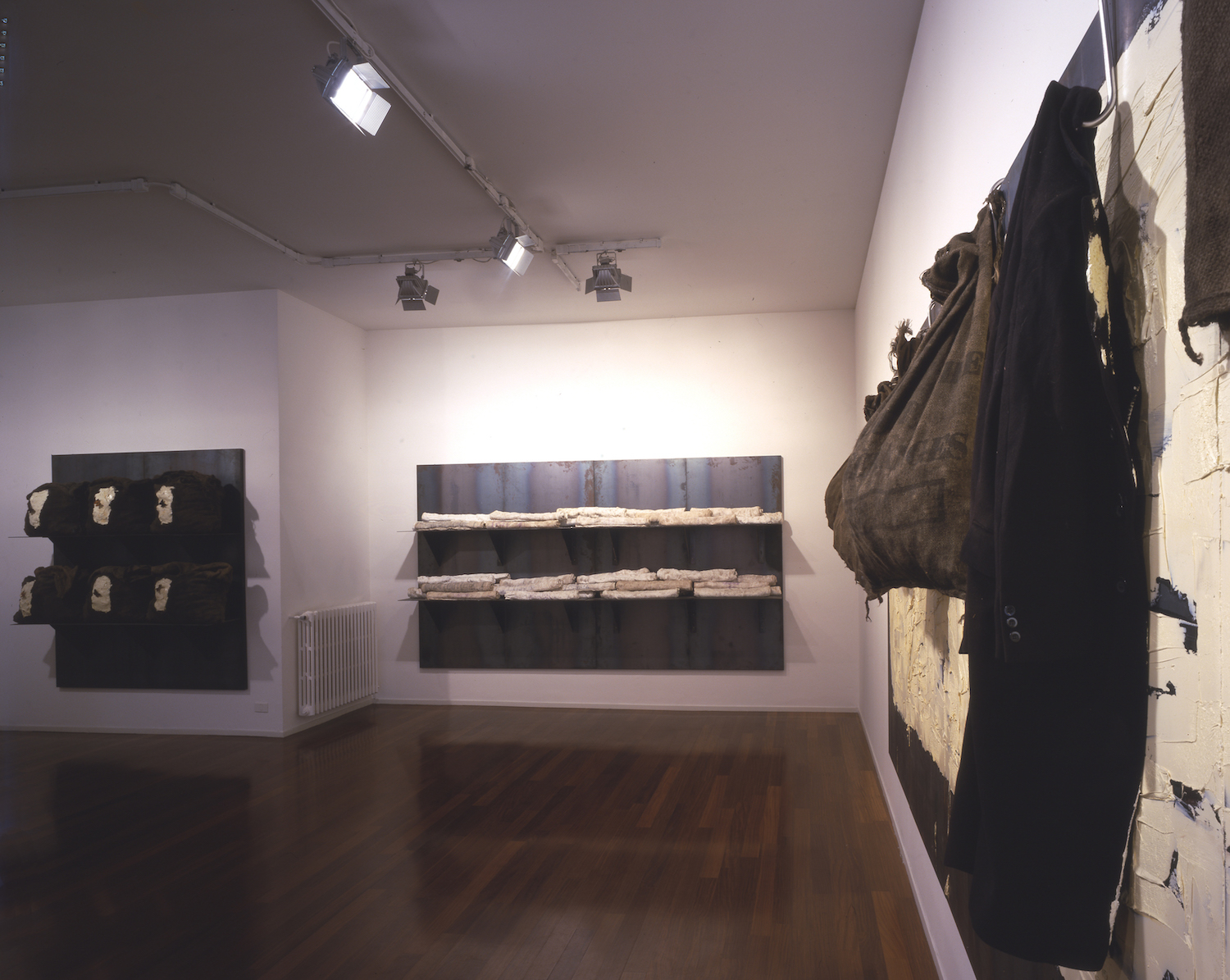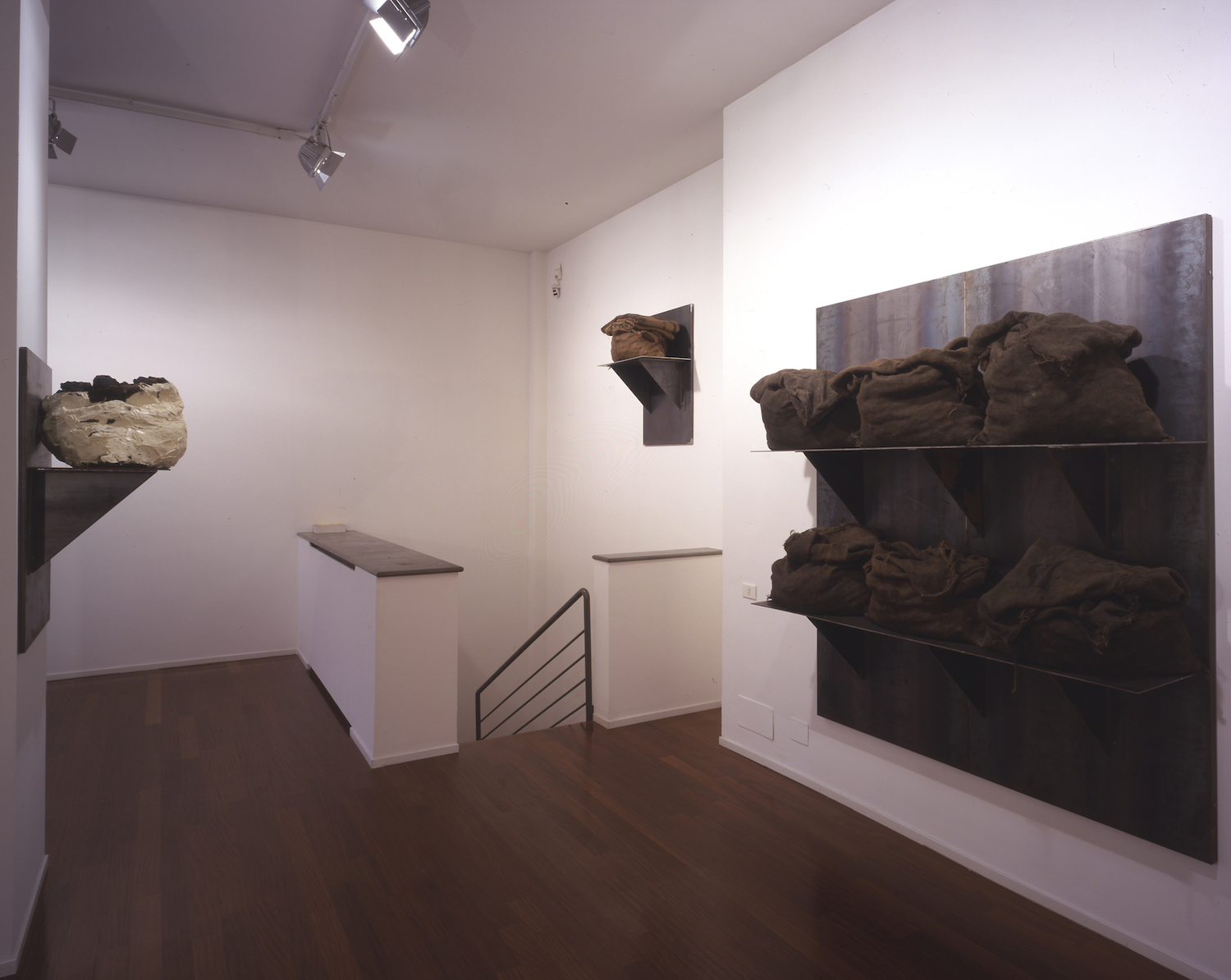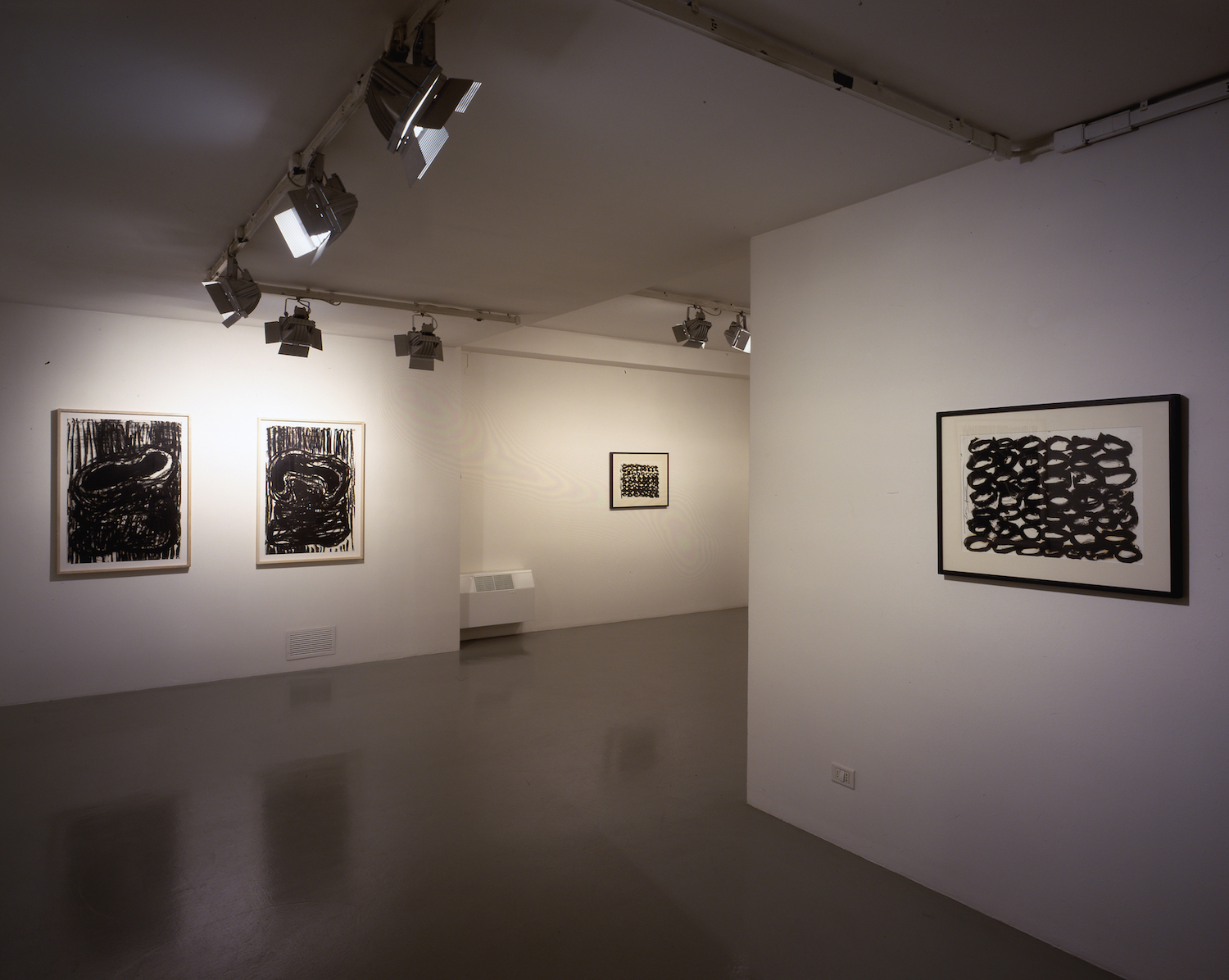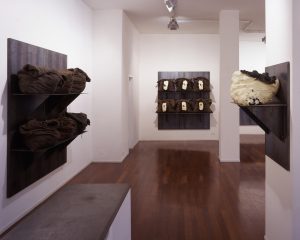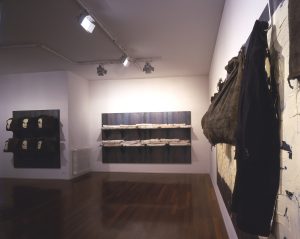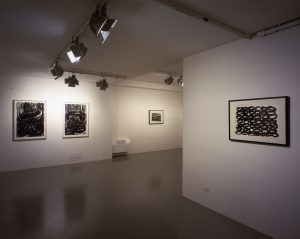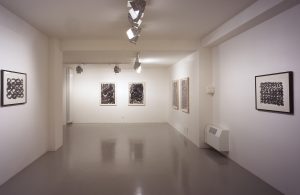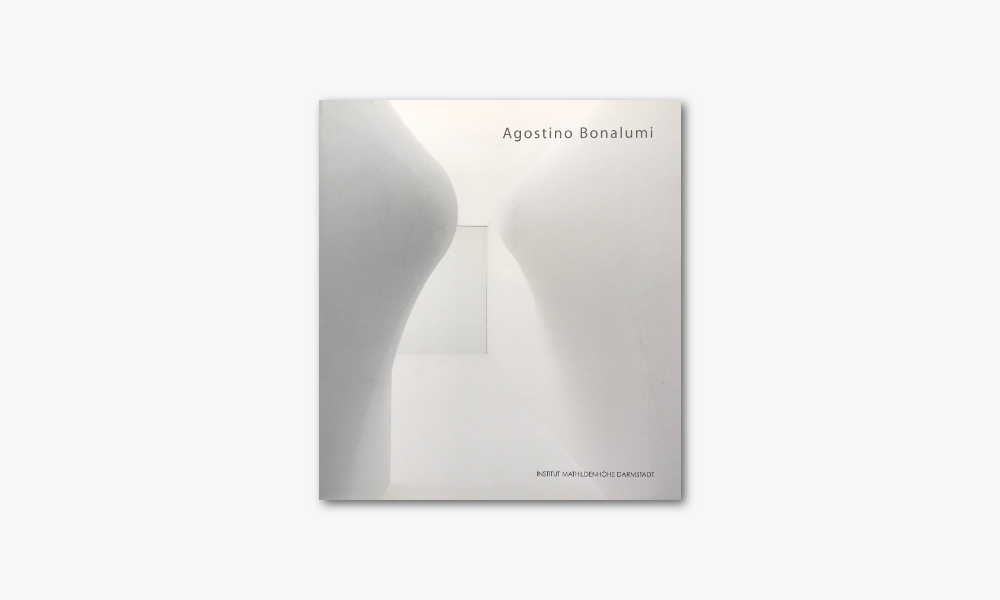
JANNIS KOUNELLIS
OPERE RECENTI
28 October to 6 December 2003
JANNIS KOUNELLIS
OPERE RECENTI
28 October to 6 December 2003

Text
Galleria Fumagalli presents a new exhibition by Jannis Kounellis with some new works by the artist. On the ground floor are exhibited some large works in which the “objects”, emotional and formal fragments of which Kounellis’s works are made dialogue with a new element which has been recently reintroduced by the artist: painting. Substantial and thick, spread on the surface of the sheets, it preserves spontaneously and immediately the human gesture, which is emphasized as a symbol of human conscience. It is not an object hence it is not an image, and it is not a material, but it is matter; it does not propose a vision, but a further pathos which gives drama and effectiveness to the work. The proposal is radical. In the use of light painting and of objects and iron – which tend to be dark – all the emotional efficacy of black and white pictorial extremes is manifested so as to regain space, and become the protagonist again. In the large-scale works set up at the gallery, the painting dialogues with some objects and a natural element. A series of works on paper are exhibited in the gallery basement. Since the 1960s Kounellis’ painting, sculpture, settings, installations and performances – with their material poverty, witnesses of a precise cultural and ethical commitment – have modified the archaic model of representation on the canvas by providing an infinite breadth and starting a new process of fruition of this open work which is able to totally involve the viewer. This work broke the boundaries anchored to the multiple historical identities and redefined a new compositional requirement. It is a spatial interaction between images and objects, in order to bring the viewer back to a single and unmistakable vision, image as vision.
As Jannis Kounellis describes: «…in art there is no evolution that is independent of the events that determine it …» and again: «… I think that my greatest aspiration… is to become a needle to sew everything together, … sew up everything again …» and again «I will not be able to recompose the totality, but the honest attempt of a painter is to try …». The drama inherent in his works is very strong, deriving from the comparison between the objects which is immediate and radical. Jannis Kounellis, a Greek-born artist (Piraeus, Athens, 1936), arrived in Italy in 1956 and settled in Rome, where he studied at the Academy of Fine Arts under the guidance of Toti Scialoja. Since the beginning the works by Burri and Fontana, such as those by Pollock, Kline and Rauschenberg, are fundamental in his training. His first solo exhibition (1960) at Galleria La Tartaruga in Rome dates back to the Academy’s years. Starting in 1967 fire, earth, wool, coal, jute sacks, plants and animals became part of the work in a dialectic between inert forms and living forms. From that time an iron plate replaces the canvas, shelves support objects of everyday use and the concept of “measure” is developed, derived from the dimensions of the drawing sheet, of the double bed or the door. In the same year he took part in the group exhibition Arte Povera and IM Spazio curated by Germano Celant at Galleria La Bertesca in Genoa. The work is no longer something to be viewed but becomes something to be experienced. In this sense, Kounellis’ artistic research is upgraded with one of his most famous installations, Senza Titolo (12 cavalli), from 1969, in which he arranges twelve live horses in the hall of Galleria L’Attico as evidence of the relationship between the artistic-cultural space and the natural one.
In 1972 he shuts his mouth with a gold cast and in 1976 contaminates the rooms of Gallery Ala, Milan with the black smoke of a chimney. In 1972 he was invited for the first time to exhibit at the 25th Venice Biennale. He took part in the exhibition “Zeitgeist” (1982) in Berlin. In 1986 at the Museum of Contemporary Art in Chicago, a large anthology was set up. Radicale is the exhibition in Barcelona in 1989: in the spaces of the Espai Poublenou quarters of freshly slaughtered ox are hung with hooks to iron plates and tragically illuminated by oil lamps. In the same year he presented an installation at the Reggia di Capodimonte in Naples. In 1991 two key events follow one another, respectively at the New Tretjakov in Moscow and at the Stommeln Synagogue in Pulheim. In Naples in 1996 he hung some furniture from the portico of Piazza Plebiscito. In 1994 in a disused ship docked in the port of Piraeus, the artist makes a selection of works spanning thirty years of career under the title of Cargo Ionion. In these last years Kounellis’ work reaches Mexico (1999), Argentina (2000) and Uruguay (2001), where the artist presents his typical form of expression in different ways. On 21 April 2002, on the occasion of a series of performances from the 1960s and 1970s restaged by the Whitechapel, London the artist chose 12 horses to witness the conquest of the architectural space. For the Galleria Nazionale d’Arte Moderna in Rome, in 2002 he set up an imposing metal labyrinth in which he created specific places where he performed some of his visions. In 2003, under the patronage of the United Nations Department of Public Information and the city of Venice, he presented a series of works designed for the court, the book deposit, and the 18th century museum of the Armenian Monastery located on the island of San Lazzaro in Venice.
Text
Galleria Fumagalli presents a new exhibition by Jannis Kounellis with some new works by the artist. On the ground floor are exhibited some large works in which the “objects”, emotional and formal fragments of which Kounellis’s works are made dialogue with a new element which has been recently reintroduced by the artist: painting. Substantial and thick, spread on the surface of the sheets, it preserves spontaneously and immediately the human gesture, which is emphasized as a symbol of human conscience. It is not an object hence it is not an image, and it is not a material, but it is matter; it does not propose a vision, but a further pathos which gives drama and effectiveness to the work. The proposal is radical. In the use of light painting and of objects and iron – which tend to be dark – all the emotional efficacy of black and white pictorial extremes is manifested so as to regain space, and become the protagonist again. In the large-scale works set up at the gallery, the painting dialogues with some objects and a natural element. A series of works on paper are exhibited in the gallery basement. Since the 1960s Kounellis’ painting, sculpture, settings, installations and performances – with their material poverty, witnesses of a precise cultural and ethical commitment – have modified the archaic model of representation on the canvas by providing an infinite breadth and starting a new process of fruition of this open work which is able to totally involve the viewer. This work broke the boundaries anchored to the multiple historical identities and redefined a new compositional requirement. It is a spatial interaction between images and objects, in order to bring the viewer back to a single and unmistakable vision, image as vision.
As Jannis Kounellis describes: «…in art there is no evolution that is independent of the events that determine it …» and again: «… I think that my greatest aspiration… is to become a needle to sew everything together, … sew up everything again …» and again «I will not be able to recompose the totality, but the honest attempt of a painter is to try …». The drama inherent in his works is very strong, deriving from the comparison between the objects which is immediate and radical. Jannis Kounellis, a Greek-born artist (Piraeus, Athens, 1936), arrived in Italy in 1956 and settled in Rome, where he studied at the Academy of Fine Arts under the guidance of Toti Scialoja. Since the beginning the works by Burri and Fontana, such as those by Pollock, Kline and Rauschenberg, are fundamental in his training. His first solo exhibition (1960) at Galleria La Tartaruga in Rome dates back to the Academy’s years. Starting in 1967 fire, earth, wool, coal, jute sacks, plants and animals became part of the work in a dialectic between inert forms and living forms. From that time an iron plate replaces the canvas, shelves support objects of everyday use and the concept of “measure” is developed, derived from the dimensions of the drawing sheet, of the double bed or the door. In the same year he took part in the group exhibition Arte Povera and IM Spazio curated by Germano Celant at Galleria La Bertesca in Genoa. The work is no longer something to be viewed but becomes something to be experienced. In this sense, Kounellis’ artistic research is upgraded with one of his most famous installations, Senza Titolo (12 cavalli), from 1969, in which he arranges twelve live horses in the hall of Galleria L’Attico as evidence of the relationship between the artistic-cultural space and the natural one.
In 1972 he shuts his mouth with a gold cast and in 1976 contaminates the rooms of Gallery Ala, Milan with the black smoke of a chimney. In 1972 he was invited for the first time to exhibit at the 25th Venice Biennale. He took part in the exhibition “Zeitgeist” (1982) in Berlin. In 1986 at the Museum of Contemporary Art in Chicago, a large anthology was set up. Radicale is the exhibition in Barcelona in 1989: in the spaces of the Espai Poublenou quarters of freshly slaughtered ox are hung with hooks to iron plates and tragically illuminated by oil lamps. In the same year he presented an installation at the Reggia di Capodimonte in Naples. In 1991 two key events follow one another, respectively at the New Tretjakov in Moscow and at the Stommeln Synagogue in Pulheim. In Naples in 1996 he hung some furniture from the portico of Piazza Plebiscito. In 1994 in a disused ship docked in the port of Piraeus, the artist makes a selection of works spanning thirty years of career under the title of Cargo Ionion. In these last years Kounellis’ work reaches Mexico (1999), Argentina (2000) and Uruguay (2001), where the artist presents his typical form of expression in different ways. On 21 April 2002, on the occasion of a series of performances from the 1960s and 1970s restaged by the Whitechapel, London the artist chose 12 horses to witness the conquest of the architectural space. For the Galleria Nazionale d’Arte Moderna in Rome, in 2002 he set up an imposing metal labyrinth in which he created specific places where he performed some of his visions. In 2003, under the patronage of the United Nations Department of Public Information and the city of Venice, he presented a series of works designed for the court, the book deposit, and the 18th century museum of the Armenian Monastery located on the island of San Lazzaro in Venice.
Installation views
Installation views



